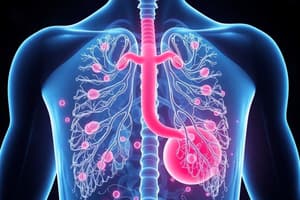Podcast
Questions and Answers
Which enzyme is almost completely liver specific in dogs and cats?
Which enzyme is almost completely liver specific in dogs and cats?
- ALT (correct)
- CK
- AST
- ALKP
What is the half-life of ALT in dogs?
What is the half-life of ALT in dogs?
- 40-60 hours (correct)
- 3.5 hours
- 6 hours
- 60-70 hours
What enzyme is membrane located in the canalicular region and is induced by impaired biliary flowing medications?
What enzyme is membrane located in the canalicular region and is induced by impaired biliary flowing medications?
- ALKP (correct)
- ALT
- CK
- AST
Which enzyme is more biliary specific?
Which enzyme is more biliary specific?
What can be used to assess renal function?
What can be used to assess renal function?
What does a high urea level with normal creatinine suggest?
What does a high urea level with normal creatinine suggest?
What should be measured to assess hydration?
What should be measured to assess hydration?
Which enzyme is an indicator of liver damage but does not correlate to diffuseness or severity of the lesion?
Which enzyme is an indicator of liver damage but does not correlate to diffuseness or severity of the lesion?
Which pancreatic enzyme is released into the circulation in the case of autodigestion, such as pancreatitis?
Which pancreatic enzyme is released into the circulation in the case of autodigestion, such as pancreatitis?
Which enzyme shows immunological attacks in the thyroid?
Which enzyme shows immunological attacks in the thyroid?
Which indicator tells us that something bad is happening to kidney cells?
Which indicator tells us that something bad is happening to kidney cells?
Which indicator is used to measure pancreatic function and is affected by exopancreatic insufficiencies?
Which indicator is used to measure pancreatic function and is affected by exopancreatic insufficiencies?
Which indicators are used to assess renal functionality?
Which indicators are used to assess renal functionality?
Which indicator is released when muscle cells are stretched, indicating cardiac enlargement and valve insufficiency?
Which indicator is released when muscle cells are stretched, indicating cardiac enlargement and valve insufficiency?
Which enzyme is a muscle enzyme and a hepatic enzyme, making its interpretation complex?
Which enzyme is a muscle enzyme and a hepatic enzyme, making its interpretation complex?
Which of the following is a likely cause of elevated glucose levels in cats?
Which of the following is a likely cause of elevated glucose levels in cats?
What is the most direct way to measure the physiological calcium status in an egg laying species?
What is the most direct way to measure the physiological calcium status in an egg laying species?
Which of the following is a possible cause of hypercalcemia in horses and rabbits?
Which of the following is a possible cause of hypercalcemia in horses and rabbits?
Which of the following is a preferred acute phase protein (APP) marker in cats?
Which of the following is a preferred acute phase protein (APP) marker in cats?
Which of the following is NOT a possible cause of hypocalcemia?
Which of the following is NOT a possible cause of hypocalcemia?
What are the indicators used to assess renal functionality?
What are the indicators used to assess renal functionality?
What enzyme is membrane located in the canalicular region and is induced by impaired biliary flowing medications?
What enzyme is membrane located in the canalicular region and is induced by impaired biliary flowing medications?
Which enzyme is a muscle enzyme and a hepatic enzyme, making its interpretation complex?
Which enzyme is a muscle enzyme and a hepatic enzyme, making its interpretation complex?
What is the significance of measuring enzyme levels in circulation?
What is the significance of measuring enzyme levels in circulation?
What factors can lead to increased enzyme levels in circulation despite minimal hepatocyte damage?
What factors can lead to increased enzyme levels in circulation despite minimal hepatocyte damage?
How can enzyme levels in circulation be used to monitor pathology progression?
How can enzyme levels in circulation be used to monitor pathology progression?
What are some possible causes of hypocalcemia in cats?
What are some possible causes of hypocalcemia in cats?
What are some possible causes of hypercalcemia in horses and rabbits?
What are some possible causes of hypercalcemia in horses and rabbits?
What are some factors that can affect the interpretation of ALT and ALKP levels in different species?
What are some factors that can affect the interpretation of ALT and ALKP levels in different species?
What are some indicators used to assess renal functionality?
What are some indicators used to assess renal functionality?
Flashcards are hidden until you start studying





